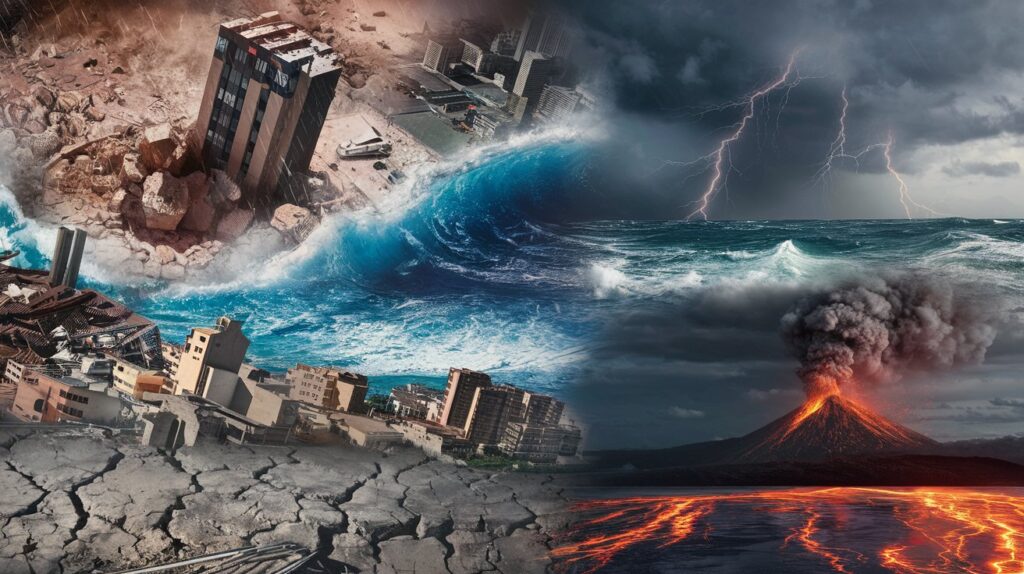
Introduction
Natural disaster have been a portion of Earth’s history for millions of a long time, forming the scene and influencing the lives of endless species, counting people. These disastrous occasions, regularly erratic and annihilating, remind us of the sheer control of nature. In this article, we will investigate different sorts of common calamities, dig into interesting realities, and examine how people can way better get ready for these events.
Types of Characteristic Disasters
Natural fiascos come in numerous shapes, each with one of a kind characteristics and impacts. Here are a few of the most common types:
- Earthquakes
Earthquakes happen when there is a sudden discharge of vitality in the Earth’s outside, driving to seismic waves. This vitality discharge is ordinarily caused by structural plates moving or volcanic activity.
Fact: The most capable seismic tremor ever recorded was the Awesome Chilean Seismic tremor on May 22, 1960, with a greatness of 9.5.
Impact: Seismic tremors can cause buildings to collapse, trigger avalanches, and result in tsunamis.
- Tsunamis
Tsunamis are gigantic waves caused by submerged seismic tremors, volcanic ejections, or avalanches. They can travel over whole sea bowls and cause broad destruction upon coming to land.
Fact: The 2004 Indian Sea torrent, activated by a 9.1 greatness seismic tremor, claimed the lives of roughly 230,000 individuals over 14 countries.
Impact: Tsunamis can devastate coastal communities, lead to noteworthy misfortune of life, and disturb ecosystems.
- Volcanic Eruptions
Volcanic ejections happen when magma from underneath the Earth’s outside is ousted through a spring of gushing lava. This can result in the discharge of fiery remains, magma, and gases.
Fact: The emission of Mount Vesuvius in 79 Advertisement buried the Roman cities of Pompeii and Herculaneum beneath a thick layer of volcanic ash.
Impact: Volcanic emissions can cause misfortune of life, crush foundation, and affect the climate.
- Tropical storms and Typhoons
Hurricanes and tropical storms are capable tropical storms that shape over warm sea waters. They are characterized by solid winds, overwhelming precipitation, and storm surges.
Fact: Tropical storm Katrina, which struck the Inlet Coast of the Joined together States in 2005, is one of the costliest characteristic fiascos in U.S. history, with harms surpassing $125 billion.
Impact: These storms can lead to broad flooding, harm to foundation, and relocation of populations.
- Floods
Floods happen when water floods onto ordinarily dry arrive, frequently as a result of overwhelming precipitation, storm surges, or the disappointment of dams and levees.
Fact: The 1931 China surges are considered the deadliest common calamity in recorded history, with an evaluated passing toll between 1 to 4 million people.
Impact: Surges can devastate homes, sully water supplies, and lead to episodes of waterborne diseases.
- Tornadoes
Tornadoes are quickly turning columns of discuss that expand from rainstorms to the ground. They are known for their dangerous control and sudden formation.
Fact: The Tri-State Tornado of 1925 is the deadliest tornado in U.S. history, with 695 fatalities as it traveled over Missouri, Illinois, and Indiana.
Impact: Tornadoes can crush whole communities, evacuate trees, and cause critical misfortune of life and property.
- Landslides
Landslides happen when a mass of shake, soil, or flotsam and jetsam moves down a incline, regularly activated by overwhelming rain, seismic tremors, or volcanic activity.
Fact: The 1980 emission of Mount St. Helens activated the biggest avalanche in recorded history, covering an region of around 24 square miles.
Impact: Avalanches can bury homes, streets, and streams, driving to misfortune of life and disturbance of transportation.
Interesting Realities Approximately Characteristic Disasters
While normal catastrophes are regularly related with catastrophe and devastation, they moreover offer captivating bits of knowledge into the Earth’s forms and the strength of life. Here are a few curiously realities almost normal disasters:
- Lightning Strikes and Volcanoes
During volcanic emissions, lightning can happen inside the fiery debris cloud. This marvel, known as volcanic lightning, is caused by the contact of fiery debris particles making electrical charges.
- The “Ring of Fire”
The Pacific Ring of Fire is a horseshoe-shaped range in the Pacific Sea bowl known for its tall levels of seismic action, counting seismic tremors and volcanic ejections. Almost 75% of the world’s dynamic volcanoes are found here.
- Tidal wave Location Systems
After the 2004 Indian Sea torrent, nations around the world contributed in torrent discovery frameworks. These frameworks utilize sensors on the sea floor to identify undersea seismic tremors and foresee potential tsunamis, giving early notices to coastal populations.
- Typhoons and Names
The hone of naming tropical storms started in the early 20th century to offer assistance distinguish and communicate around storms. Nowadays, there is a turning list of names utilized for storms, and names of especially dangerous or expensive tropical storms are retired.
- Worldwide Warming and Normal Disasters
Climate alter is anticipated to increment the recurrence and concentrated of certain common calamities, especially extraordinary climate occasions like storms, surges, and heatwaves. Rising ocean levels moreover contribute to more serious coastal flooding.
- The Deadliest Volcano
Mount Tambora in Indonesia holds the record for the deadliest volcanic ejection in history. The ejection in 1815 caused an assessed 92,000 passings, numerous from the coming about starvation and disease.
- Tornado Alley
The central Joined together States, known as Tornado Back street, encounters the most elevated recurrence of tornadoes in the world. This range incorporates parts of Texas, Oklahoma, Kansas, and Nebraska.
- The Saffir-Simpson Scale
Hurricanes are categorized utilizing the Saffir-Simpson Typhoon Wind Scale, which positions storms from Category 1 (slightest extreme) to Category 5 (most serious) based on their maintained wind speeds.
- Seismic tremor Prediction
While anticipating the correct time and area of an seismic tremor remains challenging, researchers have made advance in recognizing districts at hazard and understanding the designs of seismic activity.
- Volcanic Winter
Large volcanic emissions can discharge sufficient fiery remains and sulfur dioxide into the climate to piece daylight, driving to a brief cooling of the Earth’s surface. This wonder, known as a “volcanic winter,” can affect worldwide climate designs and agriculture.
How to Get ready for Common Disasters
While normal catastrophes are inescapable, readiness can essentially diminish their affect on lives and property. Here are a few tips for planning for distinctive sorts of characteristic disasters:
- Make an Crisis Plan
Having a well-thought-out crisis arrange is significant. This incorporates recognizing secure regions in your domestic, knowing departure courses, and having a communication arrange with family members.
- Amass an Crisis Kit
An crisis unit ought to incorporate fundamental supplies such as water, non-perishable nourishment, solutions, a electric lamp, batteries, a firstvast sea separations at mind blowing speeds and can cause disastrous harm when they reach coastal areas.
Fact: The 2004 Indian Sea tidal wave, activated by a 9.1-9.3 size seismic tremor, slaughtered over 230,000 individuals over 14 countries.
Impact: Tsunamis can immerse coastal locales, devastate foundation, and lead to noteworthy misfortune of life.
- Volcanic Eruptions
Volcanic emissions happen when magma from underneath the Earth’s surface is removed through a well of lava. These ejections can run from moderately gentle to amazingly explosive.
Fact: The ejection of Mount Tambora in 1815 is considered the most capable in recorded history, driving to the “Year Without a Summer” due to the gigantic sum of cinder in the atmosphere.
Impact: Volcanic emissions can deliver magma streams, ashfall, pyroclastic streams, and volcanic gasses, which can demolish encompassing ranges and influence worldwide climate.
- Typhoons, Tropical storms, and Cyclones
These terms allude to the same sort of storm framework, but their names shift depending on the locale. These effective tropical storms are characterized by tall winds, overwhelming precipitation, and storm surges.
Fact: Tropical storm Katrina, which struck the Inlet Coast of the Joined together States in 2005, caused over $125 billion in harm and is one of the costliest characteristic fiascos in U.S. history.
Impact: These storms can lead to far reaching flooding, wind harm, and noteworthy misfortune of life.
- Floods
Floods happen when water floods onto regularly dry arrive. This can be due to overwhelming precipitation, waterway flood, storm surges, or dam failure.
Fact: The 1931 China surges are considered the deadliest common calamity of the 20th century, with an assessed passing toll extending from 1 to 4 million people.
Impact: Flooding can crush homes, uproot populaces, and lead to waterborne diseases.
- Wildfires
Wildfires are uncontrolled fires that spread quickly through vegetation, regularly in forested or prairie zones. They can be started by normal causes such as lightning or by human activity.
Fact: The 2019-2020 Australian bushfire season, too known as “Dark Summer,” burned over 46 million sections of land, crushed thousands of buildings, and slaughtered at slightest 33 people.
Impact: Rapidly spreading fires can cause misfortune of life, devastation of property, and long-term biological damage.
- Landslides
Landslides happen when shake, soil, or flotsam and jetsam moves down a slant due to gravity. They can be activated by seismic tremors, volcanic movement, or overwhelming rainfall.
Fact: The 1980 ejection of Mount St. Helens in the U.S. activated one of the biggest avalanches in recorded history.
Impact: Avalanches can bury communities, devastate foundation, and lead to critical financial losses.
- Droughts
Droughts are drawn out periods of unusually moo precipitation, driving to water deficiencies, trim disappointments, and other natural impacts.
Fact: The Clean Bowl of the 1930s in the Joined together States was a extreme dry season that, combined with destitute agrarian hones, driven to enormous clean storms and broad rural collapse.
Impact: Dry spells can lead to nourishment and water deficiencies, financial misfortunes in farming, and expanded rapidly spreading fire risk.
- Tornadoes
Tornadoes are brutally turning columns of discuss that amplify from rainstorms to the ground. They are among the most capable and damaging climate marvels on Earth.
Fact: The deadliest tornado in recorded history struck Bangladesh in 1989, murdering roughly 1,300 people.
Impact: Tornadoes can annihilate buildings, lift vehicles, and cause extreme wounds or fatalities.
Causes and Contributing Factors
While normal catastrophes are essentially caused by characteristic powers, human exercises can worsen their impacts or increment their recurrence. For example:
Climate Alter: Human-induced climate alter is expanding the recurrence and concentrated of certain characteristic fiascos, such as storms, rapidly spreading fires, and surges. Rising worldwide temperatures contribute to more extraordinary climate designs, drawn out dry spells, and dissolving ice caps, which can lead to higher ocean levels and more serious storm surges.
Deforestation: The evacuation of trees and vegetation can destabilize the soil, making ranges more vulnerable to avalanches and expanding the chance of flooding by diminishing the land’s capacity to assimilate water.
Urbanization: As cities grow, more individuals and framework are set in harm’s way. Urbanization can moreover increment the chance of heatwaves, flooding, and other calamities by modifying characteristic scenes and making warm islands.
Poor Arrive Administration: Unsustainable rural hones, such as overgrazing and dishonorable water system, can debase the arrive and increment the probability of dry spells, desertification, and landslides.
The Human Toll and Financial Impact
Natural catastrophes can have annihilating impacts on human life and economies. In expansion to the quick misfortune of life and property, the long-term impacts can be profound.
- Misfortune of Life and Injuries
Natural fiascos can cause mass casualties, with a few occasions claiming thousands or indeed millions of lives. Wounds supported amid these fiascos can be serious, requiring broad restorative care and rehabilitation.
- Displacement
Natural calamities can constrain individuals to escape their homes, driving to relocation and the creation of displaced people. This can result in packed covers, strained assets, and long-term challenges in modifying communities.
- Financial Losses
The financial affect of normal catastrophes can be stunning. The taken a toll of modifying framework, homes, and businesses can reach billions of dollars. In expansion, common fiascos can disturb nearby economies, driving to work misfortunes, diminished efficiency, and long-term financial instability.
- Natural Damage
Beyond the prompt annihilation, characteristic fiascos can have long-lasting impacts on the environment. Fierce blazes can devastate environments, surges can sully water supplies, and typhoons can lead to soil disintegration and misfortune of biodiversity.
Arrangement and Mitigation
While characteristic fiascos cannot be avoided, steps can be taken to decrease their affect and improve versatility. Here are a few key strategies:
- Early Caution Systems
Developing and actualizing early caution frameworks can spare lives by giving progress take note of looming fiascos. These frameworks can incorporate seismic tremor sensors, climate estimating, and tidal wave caution networks.
- Disaster-Resistant Infrastructure
Building codes and framework plan can be adjusted to withstand characteristic fiascos. For case, structures in earthquake-prone zones can be built to stand up to seismic action, and homes in flood-prone districts can be elevated.
- Instruction and Awareness
Public instruction campaigns can offer assistance individuals get it the dangers of normal fiascos and how to plan. This can incorporate educating communities around clearing courses, crisis units, and security protocols.
- Natural Conservation
Protecting and reestablishing normal biological systems can offer assistance relieve the impacts of common calamities. For illustration, wetlands can act as normal buffers against storm surges, and woodlands can stabilize soil and decrease the chance of landslides.
- Climate Alter Mitigation
Addressing the root causes of climate alter can decrease the recurrence and escalated of certain normal catastrophes. This incorporates lessening nursery gas outflows, transitioning to renewable vitality, and advancing maintainable arrive utilize practices.
Conclusion
Natural fiascos are effective updates of the energetic and now and then dangerous powers of nature. Whereas we cannot anticipate these occasions, understanding their causes, impacts, and ways to plan can offer assistance minimize their impacts. By taking proactive measures, from making strides foundation to advancing natural preservation, we can construct more flexible communities that are superior prepared to withstand nature’s fury.
As the recurrence and seriousness of characteristic fiascos proceed to increment due to climate alter and other components, it is more critical than ever to contribute in calamity readiness, reaction, and recuperation endeavors. Through collective activity, we can diminish the human and financial toll of these disastrous occasions and guarantee a more secure, more maintainable future for all.



